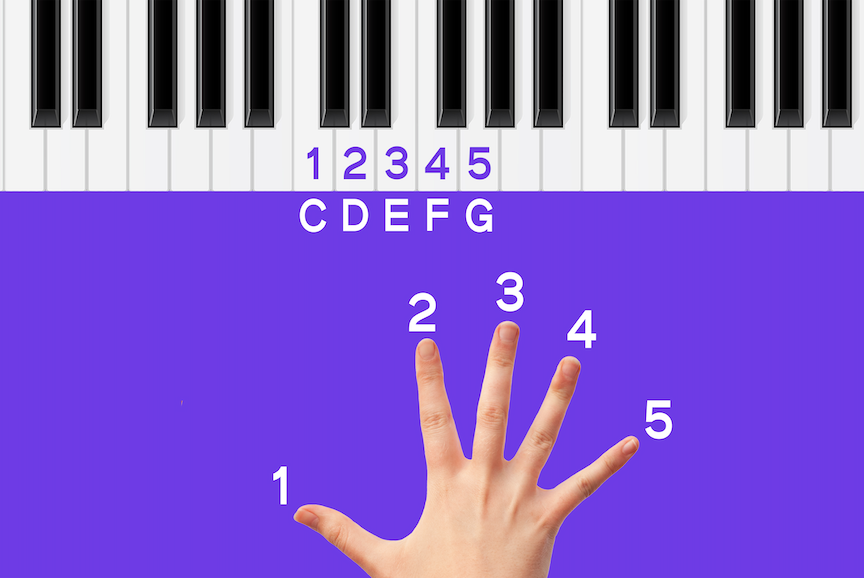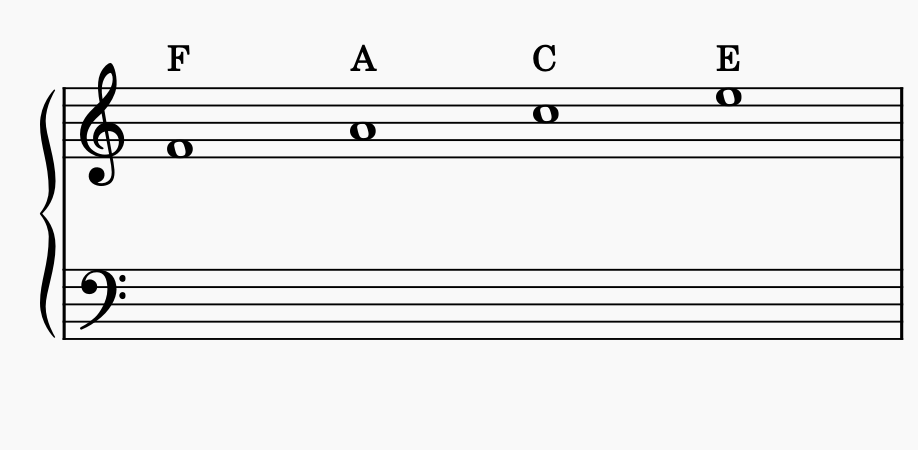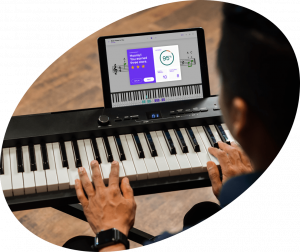Why should I learn to read sheet music?
One of the most common questions about learning piano beginners ask is: “Do I need to learn sheet music to play piano?” The answer is no, but it helps a lot. But why is it important to learn how to read sheet music for piano? Reading music is deeply pleasurable. It will help you to discover musical patterns in writing, which will strengthen your musical imagination and make your piano playing clearer and more beautiful.
Of course, the ability to read music is not just pleasurable, but also useful. Music literacy will help you learn a lot of music that’s too long or complicated to play by ear. Last but not least, music literacy opens up possibilities for writing music, whether you’re interested in arranging (reworking pieces of music for other instruments), transcribing (writing down what you hear in recordings), or creating original compositions.
In what follows, we’ll explore the magic of music notation. We’ll learn the basic elements and give you enough of a foundation that you can explore some sheet music on your own.
What is music notation?
One good way to start reading music is by taking a look at the sheet music for a melody that you already know. For example, here’s the sheet music for the nursery rhyme “Are you sleeping, Brother John?” (also known as “Frère Jacques”):

Don’t let any unfamiliar symbols scare you off! You don’t need to understand every symbol you see to read along, and you can use your ears to guide you. Think of notation as something that enhances your listening, not as something that replaces it. If you know the song, try singing it and following along with the lyrics you see. Then try playing the melody on the piano by ear, using your right hand. Hint: start on Middle C with your thumb. Then you only have to play white keys, and you don’t have to move your hand.
Here’s the hand position:

The grand staff (highlighted in red in Figure 2 below) is the set of horizontal lines where all the piano music symbols are laid out:

The grand staff breaks down into two separate five-line staves, one on top and one on the bottom. Usually, you’ll play the notes in the top staff with the right hand and the notes in the bottom staff with the left hand (in this example, there aren’t any notes for the left hand to play).
The top staff is generally marked with a treble clef and the bottom staff with a bass clef, as we see in Figure 3:

A treble clef means that the notes on that staff are higher (mostly above Middle C), while a bass clef means that they’re lower (mostly below Middle C).
Notes on (and off) the staff
For the upper staff, the lines (in ascending order) correspond to the keys E G B D F:

Sometimes you’ll hear the mnemonic “Every Good Boy Does Fine” to help remember the order.
The spaces of the upper staff (again ascending) correspond to F A C E.

Figure 4 shows the notes of the “Are you sleeping” excerpt, along with the letters for the piano keys they represent:

You can see that keys that are next to each other on the keyboard are represented by adjacent notes on the staff. For example, the lower line of the top staff is for the E key above Middle C, and the space above that is for the F key to its right. In this melody, we see most of the notes on the lines and spaces of the staff. The Middle C notes, however, are lower than the staff, so we need to write them with short, extra staff lines, called ledger lines.
Piano tempo and beats
Music notation doesn’t just show you which keys to play, but also how long to hold them. In the next section I’ll describe the symbols that have to do with rhythm and timing.
Note durations
The style of a note gives you information about its duration. In this example we see a lot of quarter notes, which are filled in (see Figure 5):

There are also a couple of half notes, which are hollow (see Figure 6).

A half note is always twice as long as a quarter note, which makes sense because 1/4 + 1/4 = 1/2. Try singing the “Are you sleeping, Brother John?” melody again: can you hear that the “John” note is twice as long as the other notes?
Some other durations are eighth notes and whole notes:
Just like you’d expect, there are two eighth notes in a quarter note, and two half notes in a whole note. In the lower staff, there are no notes, but only rests, which are symbols for silence. The rests are highlighted in Figure 7:

Each of the rests here is a whole rest, which of course is four quarter notes or rests long. Just as there are eighth, quarter, and half notes, there are also eighth, quarter, and half rests too:
Tempo basics
Tempo (Italian for “time”) just means “playing speed.” At the start of “Are you sleeping”, we see a tempo marking (or metronome marking), highlighted in Figure 8:

This tempo marking recommends a speed of 120 quarter notes per minute (that is, two quarter notes or one half note per second).
Bars, meters, and time signatures
You may have noticed that the melody is divided into four separate boxes by vertical lines, highlighted below:

Those lines are called barlines and the boxes are called bars or measures. Observe that each bar is four quarter notes long:

We can figure this out by adding together note durations, or by looking at the time signature, a pair of numbers on each staff next to the clefs.

A time signature looks sort of like a fraction, though without the dividing line between the two numbers. Basically, the top number tells us the number of notes per bar, and the bottom number gives us our reference duration. Here, 4 on the top means, “Each bar has four…”, and the 4 on the bottom means, “…quarter notes.” This is consistent with what we discovered before by counting notes.
Chords and chord symbols
Let’s give the left hand something more exciting to do. We’ll add some C major triads (3-note chords, C-E-G in the octave below Middle C) in the left hand like you see in Figure 12 below.
Each of the triads is a whole note long. In some sheet music, you may see chord symbols above the staff:

“CM” is just a shorthand for a C major chord. Sometimes you’ll see C, CMaj, or CΔ instead. There are other symbols for other chord types (minor, diminished, dominant, etc.) and voicing hints (inversions, alterations, etc.). A lead sheet is stripped-down notation that shows the melody and the chord symbols without the notes of the chords (you’re expected to figure those out from the symbols):

A chord chart is even more schematic. It shows just the chords with some slashes for rhythmic patterns (you’re expected to know the song already):

These are looser forms of notation that put more emphasis on memory, improvisation, and personal style. Jazz musicians often play from lead sheets or chord charts, while classical musicians generally use fully-notated sheet music.
Dynamic marks
You’ve now seen some ways to strip staff notation down. You can also build it up, making it even more specific. For example, here’s the “Are you sleeping” melody with dynamic marks, which are suggestions for playing softer or louder:

The “p” (an abbreviation for piano, Italian for “soft”) means “play quietly.” The “f” (forte, Italian for “strong”) means “play loudly.” The < is a crescendo, which means “get louder,” and the > is a decrescendo, which means “get quieter.”
How to practice reading sheet music
Now you’ve seen many of the basic elements of music notation, as well as some elements that are not so basic. If you’d like to learn how to practice piano with what you’ve learned so far, here are some good next steps:
- Practice reading music in piano learning app such as Playground Sessions. Playground’s software shows you interactive sheet music while highlighting the keys you need to play.
- Search online for the sheet music for other beginner piano songs that contain melodies you likely already know: nursery rhymes, jingles (“Shave and a haircut”, “Happy birthday”, etc.), maybe even some songs that you like. See how much of the notation you can figure out by ear.
- Try making up some simple melodies of your own, and writing them down. It may be helpful to break up the task into two parts: first, figuring out where to put the notes on the staff; second, figuring out the rhythms.
- Sight reading practice: write down some notes in random positions and patterns on the staff. Can you figure out which keys to play? Try the same exercise but with different rhythmic patterns.
Hopefully this chapter opened your eyes and ears to something new. Have fun reading and exploring!






